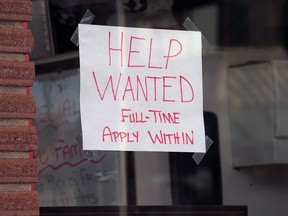Alberta’s unemployment rate rose to 6.3 per cent in March, with the province losing about 3,500 jobs. However, the province has added 83,000 jobs over the past year.

Article content
Alberta’s unemployment rate is tracking slightly above the national average, according to Statistics Canada’s monthly job report — partly due to the province’s record influx of newcomers over the past two years, economists say.
But economists say that shouldn’t cause concern for Albertans, in part because the province is contributing to more than a quarter of Canada’s job growth.
Advertisement 2
Article content
Article content
Alberta’s unemployment rate rose to 6.3 per cent in March, with the province losing about 3,500 jobs. However, Alberta has added 83,000 jobs over the past year — more than a quarter of Canada’s total gain over that 12-month stretch.
“I’m not particularly concerned about the difference between Alberta and the national average,” said Kent Fellows, economist at the University of Calgary. “It’s definitely something to keep an eye on, but I don’t think this spells doom and gloom for Alberta’s economic strategy.”
Alberta’s unemployment rate is in part explained by the record migration it has experienced over the past two years, Fellows said. According to data released last week, Alberta grew by more than 202,000 residents — more than a quarter of which came from other Canadian provinces, making it the largest interprovincial gain Alberta has experienced since data became available in 1972.
A portion of those newcomers arrive while between jobs, Fellows said.
“When that happens, you expect a certain amount of friction unemployment, this sort of churn — people come and they’re looking for jobs, and they show up in the unemployment statistics.”
Article content
Advertisement 3
Article content
Growing working-age population in Alberta’s largest cities
Over the past year, Calgary’s working-age population has grown by 5.1 per cent while Edmonton’s has increased 5.4 per cent, said Charles St-Arnaud, chief economist at Alberta Central and former economist at the Bank of Canada.
The number of employed Albertans between 25 and 54 has gone from about 1.54 million people during the worst of the pandemic in 2020 to nearly 1.7 million in late 2023, according to Alberta’s economic dashboard.
St-Arnaud said it’s a positive development for the province to be increasing its workforce, however it’s also creating strain on more “sticky” sectors such as housing and rent, where prices are reaching record numbers.
“The demand side is great, but what about the supply side of the economy? Housing, public services, infrastructure — those only adjust very slowly,” he said.
While March’s job numbers are ultimately a fraction of a wider story for Alberta’s economy, Fellows said he’ll be watching several key markers such as housing prices to understand how the province’s dramatic population increases will play out in the economy long-term.
Advertisement 4
Article content
“This is something we have to watch longer-term, and we have to be realistic about what’s going to happen. It’s a great sign of a strong economy. But it’s also, from a dynamic perspective through time, an issue when things like this happen too quickly,” Fellows said.
Josh Aldrich, press secretary to Matt Jones, minister of jobs, economy and trade, said in a statement that Alberta’s job increases are an example of “the Alberta Advantage in action.”
“Alberta’s economy is leading the nation in growth while creating good jobs for Albertans,” Aldrich wrote, citing the addition of 83,000 jobs to the province over the past year.
The Alberta NDP said in a statement that the provincial government should be focused on creating jobs.
“A growing province needs a government that is focused on increasing the services that people rely on, but the UCP has failed to deliver on diversifying the economy with more jobs,” wrote Nathan Ip, the Alberta NDP critic for jobs, economy and trade.
Article content



